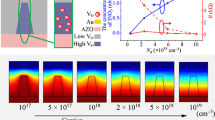Abstract
Heterolayer memristive systems with a functional aluminum oxide layer obtained by the method of atomic layer deposition are studied. A method is proposed for the arrangement of a reservoir of oxygen vacancies, which ensures the creation of a wide memory window. The proposed method uses oxygen permeable platinum electrodes in combination with an amorphous-silicon-dioxide adsorption sublayer formed by plasma-chemical deposition under the bottom electrode of the structure. It is shown that an amorphous-silicon-dioxide sublayer can play, under certain conditions, the role of a reservoir of oxygen vacancies for the functional sublayer, which provides a reversible change in the concentration of molecular oxygen in the regions adjacent to the electrodes and reversible readjustment of the resistivity of the structure within the range of seven orders of magnitude.



Similar content being viewed by others
REFERENCES
B. V. Benjamin, P. Gao, E. McQuinn, et al., Proc. IEEE 102, 699 (2014).
P. A. Merolla, J. V. Arthur, R. Alvarez-Icaza, et al., Science (Washington, DC, U. S.) 345 (6197), 668 (2014).
S. Mori, N. Qiao, F. Stefanin, et al., IEEE Trans. Biomed. Circuits Syst. 12, 106 (2018).
E. Painkras, L. A. Plana, and J. Garside, IEEE J. Solid-State Circuits 48, 1943 (2013).
M. Davies, N. Srinivasa, and T.-H. Lin, IEEE Micro 38, 82 (2018).
A. Neckar, T. C. Stewart, B. V. Benjamin, et al., in Proceedings of the IEEE International Symposium on Circuits and System ISCAS (2018), p. 1.
A. Ankit, I. El Hajj, S. R. Chalamalasetti, et al., in Proceedings of the ASPLOS’19 24th International Conference on Architectural Support for Programming Languages and Operating Systems, 2019, p. 715.
P. Yao, H. Wu, B. Gao, et al., Nature (London, U.K.) 577, 641 (2020).
Y. Shi, L. Nguyen, S. Oh, et al., Nat. Commun. 9, 5312 (2018).
Q. Liu, B. Gao, P. Yao, et al., “33.2 A fully integrated analog ReRAM based 78.4 TOPS/W compute-in-memory chip with fully parallel MAC computing,” in Proceedings of the 2020 IEEE International Solid-State Circuits Conference ISSCC, 2020, p. 500.
S. Stathopoulos, A. Khiat, M. Trapatseli, et al., Sci. Rep. 7, 17532 (2017). https://doi.org/10.1038/s41598-017-17785-1
“Memristor device,” US Patent No. 10186660B2 (2019).
N. Andreeva, A. Ivanov, and A. Petrov, AIP Adv. 8, 025208 (2018).
L. Alekseeva, T. Nabatame, T. Chikyow, et al., Jpn. J. Appl. Phys. 55, 08PB02 (2016).
A. Petrov, L. Alekseeva, A. Ivanov, et al., Nanoindustriya, No. 1, 63 (2016).
N. V. Andreeva, V. V. Luchinin, and E. A. Ryndin, “Memristive synapse,” RF Patent No. 202461 (2021).
N. V. Andreeva, P. A. Turalchuk, D. A. Chigirev, et al., Chaos, Solitons Fractals 142, 110503 (2021). https://doi.org/10.1016/j.chaos.2020.110503
D. Nečas and P. Klapetek, Cent. Eur. J. Phys. 10, 181 (2012). http://gwyddion.net/.
D. N. Goldstein and J. A. McCormick, J. Phys. Chem. 112, 19530 (2008).
G. D. Chukin, The Structure of Aluminum Oxide and Hydrodesulfurization Catalysts. Reaction Mechanisms (Paladin, Moscow, 2010) [in Russian].
M. Lübben, S. Wiefels, R. Waser, and I. Valov, Adv. Electron. Mater., 1700458 (2017). https://doi.org/10.1002/aelm.201700458
M. Y. Yang, K. Kamiya, B. Magyari-Kope, et al., Appl. Phys. Lett. 103, 093504 (2013).
D. Liu, S. J. Clark, and J. Robertson, Appl. Phys. Lett. 96, 032905 (2010). https://doi.org/10.1063/1.3293440
Funding
This study was supported by the Ministry of Science and Higher Education of the Russian Federation within State assignment FSEE-2020-0013 in the field of research activity.
Author information
Authors and Affiliations
Corresponding author
Additional information
Translated by O. Kadkin
Rights and permissions
About this article
Cite this article
Andreeva, N.V., Romanov, A.A., Mazing, D.S. et al. Heterolayer Memristive Systems for Multibit Memory: The Role of a Reservoir of Oxygen Vacancies. Nanotechnol Russia 16, 790–797 (2021). https://doi.org/10.1134/S2635167621060033
Received:
Revised:
Accepted:
Published:
Issue Date:
DOI: https://doi.org/10.1134/S2635167621060033




